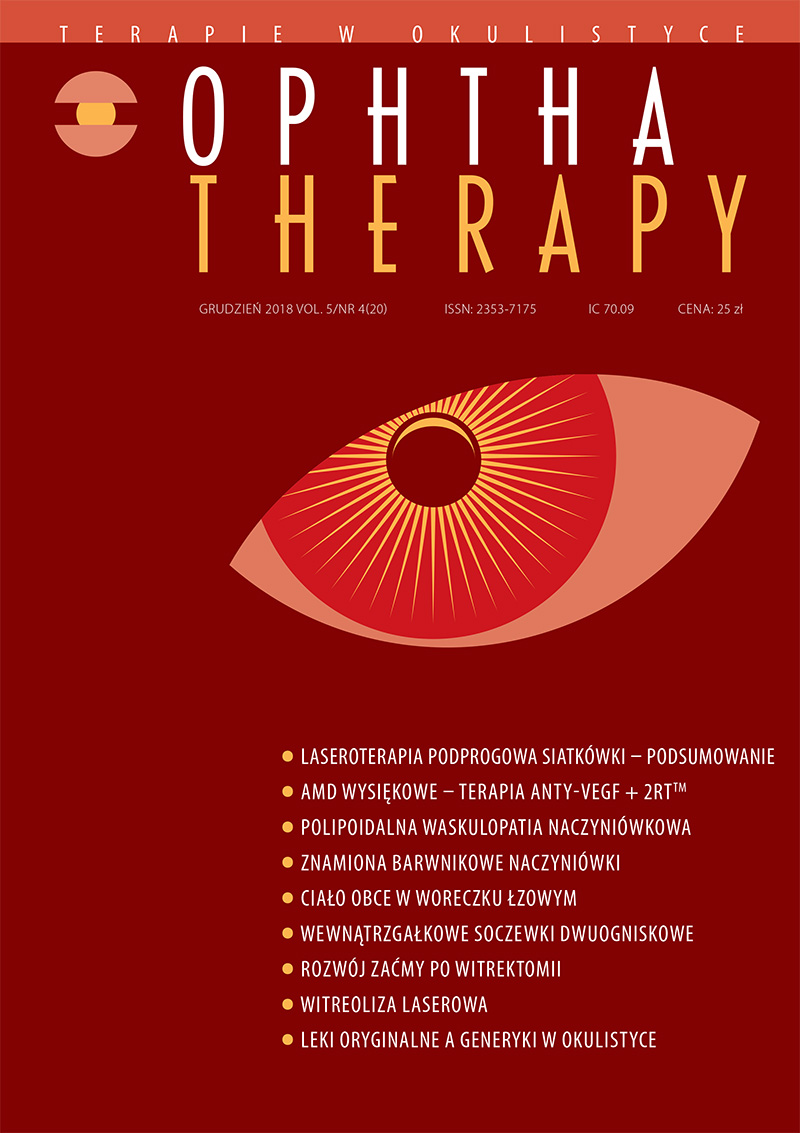Cataract formation as a complication of vitrectomy
Main Article Content
Abstract
Cataract development after vitrectomy is common due to decreased diffusion of nutrients which are necessary for proper lens metabolism and increased oxidative stress. Extended vitrectomy and the use of a tamponade agent (either gas or silicone oil) additionally accelerates cataract development. Moreover, cataract surgery in a vitrectomized eye poses a risk of complications due to zonular dehiscence, intraoperative miosis or instability of the anterior chamber. Phacovitrectomy allows faster visual rehabilitation time, excellent intraoperative visualization of the vitreous body and retina, and enables to perform a more extended vitrectomy. However, combined surgery is more difficult technically, lasts longer, and potentially might be complicated with corneal edema or Descemet membrane striae (hampering visualization of the posterior segment). A rapid adoption of combined phacovitrectomy is observed internationally.
Downloads
Article Details

This work is licensed under a Creative Commons Attribution-NonCommercial-NoDerivatives 4.0 International License.
Copyright: © Medical Education sp. z o.o. License allowing third parties to copy and redistribute the material in any medium or format and to remix, transform, and build upon the material, provided the original work is properly cited and states its license.
Address reprint requests to: Medical Education, Marcin Kuźma (marcin.kuzma@mededu.pl)
References
2. Yee KMP, Tan S, Lesnik Oberstein SY et al. Incidence of Cataract Surgery after Vitrectomy for Vitreous Opacities. Ophthalmol Retina. 2017; 1: 154-7.
3. Singh S, Byanju R, Pradhan S et al. Retrospective study on outcome of macular hole surgery. Nepal J Ophthalmol. 2016; 8: 139-43.
4. Jackson TL, Donachie PHJ, Sparrow JM et al. United Kingdom National Ophthalmology Database study of vitreoretinal surgery: report 2, macular hole. Ophthalmology. 2013; 120: 629-34.
5. Kanclerz P, Grzybowski A. Complications Associated with the Use of Expandable Gases in Vitrectomy. J Ophthalmol. 2018; 2018: 1-7.
6. Elhousseini Z, Lee E, Williamson TH. Incidence of lens touch during pars plana vitrectomy and outcomes from subsequent cataract surgery. Retina. 2016; 36: 825-9.
7. Tandogan T, Khoramnia R, Auffarth GU et al. In Vivo Imaging of Intraocular Fluidics in Vitrectomized Swine Eyes Using a Digital Fluoroscopy System. J Ophthalmol. 2016; 2016: 9695165.
8. Kanclerz P, Grzybowski A, Schwartz SG et al. Complications of cataract surgery in eyes filled with silicone oil. Eur J Ophthalmol. 2018; 28: 465-8.
9. Han JV, Patel DV, Wallace HB et al. Auckland Cataract Study III: Refining Preoperative Assessment With Cataract Risk Stratification to Reduce Intraoperative Complications. Am J Ophthalmol. 2019; 197: 114-20.
10. Cole CJ, Charteris DG. Cataract extraction after retinal detachment repair by vitrectomy: visual outcome and complications. Eye. 2008; 23: 1377-81.
11. Rey A, Jürgens I, Maseras X et al. Visual outcome and complications of cataract extraction after pars plana vitrectomy. Clin Ophthalmol. 2018; 12: 989-94.
12. Villegas VM, Gold AS, Latiff A et al. Phacovitrectomy. Dev Ophthalmol. 2014; 54: 102-7.
13. Chung TY, Chung H, Lee JH. Combined surgery and sequential surgery comprising phacoemulsification, pars plana vitrectomy, and intraocular lens implantation: comparison of clinical outcomes. J Cataract Refract Surg. 2002; 28: 2001-5.
14.VR Outcomes Database n.d. Online: http://outcomes.beavrs.org .
15. Meillon C, Gabrielle PH, Bron AM et al. Antiplatelet and anticoagulant agents in vitreoretinal surgery: a prospective multicenter study involving 804 patients. Graefes Arch Clin Exp Ophthalmol. 2018. https://doi.org/10.1007/s00417-018-4152-0.

